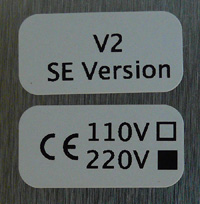This review page is supported in part by the sponsors whose ad banners are displayed below |
 |
 |
Now Richard Krol informed us that "... we had a meeting yesterday in which we discussed your review findings and how to move forward with an improved version.
We have discussed the various avenues to explore and are confident that we can improve the overall performance and, as a result, want to push forward with the developments required. We reckon that we need ca. 4-6 weeks to deliver an improved unit. As a follow-up to my initial question to review an updated version, I have a special request. In order to facilitate an update to the review, I would like to ask you if it's a problem to hold on to the units currently in your possession for a little while longer. We then ship you a new set in 4-6 weeks time after which you will then be able to evaluate these properly. When you're done we have the 4 units picked up. To address any issues which might arise with the general public, we will update every unit that has been released to the public to receive a complete overhaul of the electronics free of charge so that all customers can enjoy the latest developments. We are very keen to offer the best available performance..." |
| |
|
|
|
|
It's not often that manufacturers take review criticisms on sonics to heart and volunteer a redesign rather than taking offense. After listening sessions, Hexateq had opted for different capacitors and—expressing particular surprise over its audibility—the flying lead wiring that connects the input terminal to the board. Unfortunately the V2 pair dispatched sported the optional XLR rather than RCA inputs of the original. Richard Krol assured me that this would have no sonic effect. My Esoteric C-03 preamp's XLR i/o ports are convenience features and not matched to a balanced circuit. I also conducted this comparison with equivalent leads of Acoustic System LiveLine cables to minimize variables. Still bear in mind that I couldn't extricate the 'balanced aspect' from the equation to be certain that sonic changes were due only to the new parts. I ran the newcomers in for a few months in our upstairs 2-channel video system.
|
 |
| |
|
|
And the winner is: Even a Hollywood starlet could have called it. While gilding bits in audio can be license to charge for exotic 'approved' designer parts, Hexateq's makeover clearly wasn't gratuitous but audible and superior. For maximum resolution, I leashed up my best speakers. But already the JohnBlue Audio Art JB8s in the video system had noted differences.
|
 |
|
 |
There now was more upper-end finesse but most certainly not as a result of 'turning up the treble control'. Instead, the upper midrange to treble transition had filled out to sound more substantial and suave. This rendered the original somewhat whitish in this range - thinner and leaner.
While you'd assume that this greater embodiment benefited vocals—it did—you could also assume that it congealed the higher harmonics. Not. On albums with audible space, there were heightened hall effects to demonstrate how the V2 changes simply resolved deeper into low-level treble data without restricting themselves to just this band. The improvements included the midrange where performers now had more focus and from that, more apparent presence. |
|
|
 |
While certainly not drastic—none of the circuitry had changed—the V2 makeover via strategic parts changes had successfully injected greater magnification power without highlighting its effects as raw resolution. Rather, casual listening would first have taken note of the greater vocal embodiment, only later the keening of the spatial dimension. Very cleverly, treble hadn't gotten hotter or more pronounced. Rather, it had gotten more informative to better appreciate its overtone constituents. To implement this as a running change with retroactive conversion for present owners is a fine example of ongoing R&D and concerned customer service. I now think that Hexateq's Premium 1.0SE V2 monos are fully competitive with equivalently priced traditional topologies - except on size and power consumption where class D advantages mean more compact and energy-efficient solutions to simply win when everything else is on the level. And Hexateq's solution is most certainly on the level now. |
|
Packing: Unproblematic and quality.
Reusability of packing: Definitely.
Condition of review loaner received: Perfect.
Application conditions: 50/100wpc 8/4-ohm monos with good drive and woofer control for more real-world 'strength' than their size would suggest.
Distribution: Internet-direct from Belgium, international distributors welcome to likely be added over time.
Pricing: Competitive.
Final comments & suggestions: Ideal for multi-channel applications due to small size and thermal efficiency. Making the power mains more accessible could be a detail item for the Gen II production run. |
|
 |
|